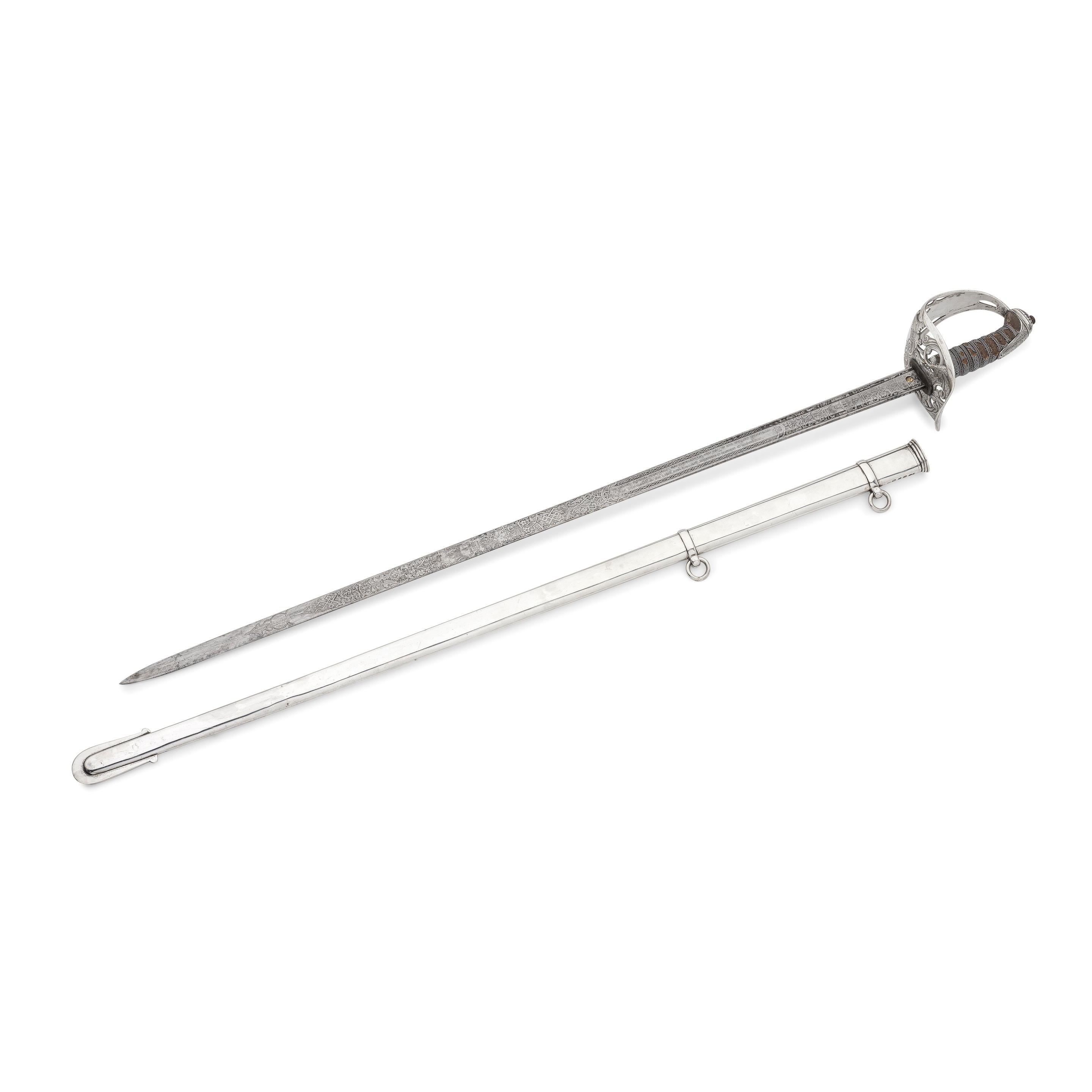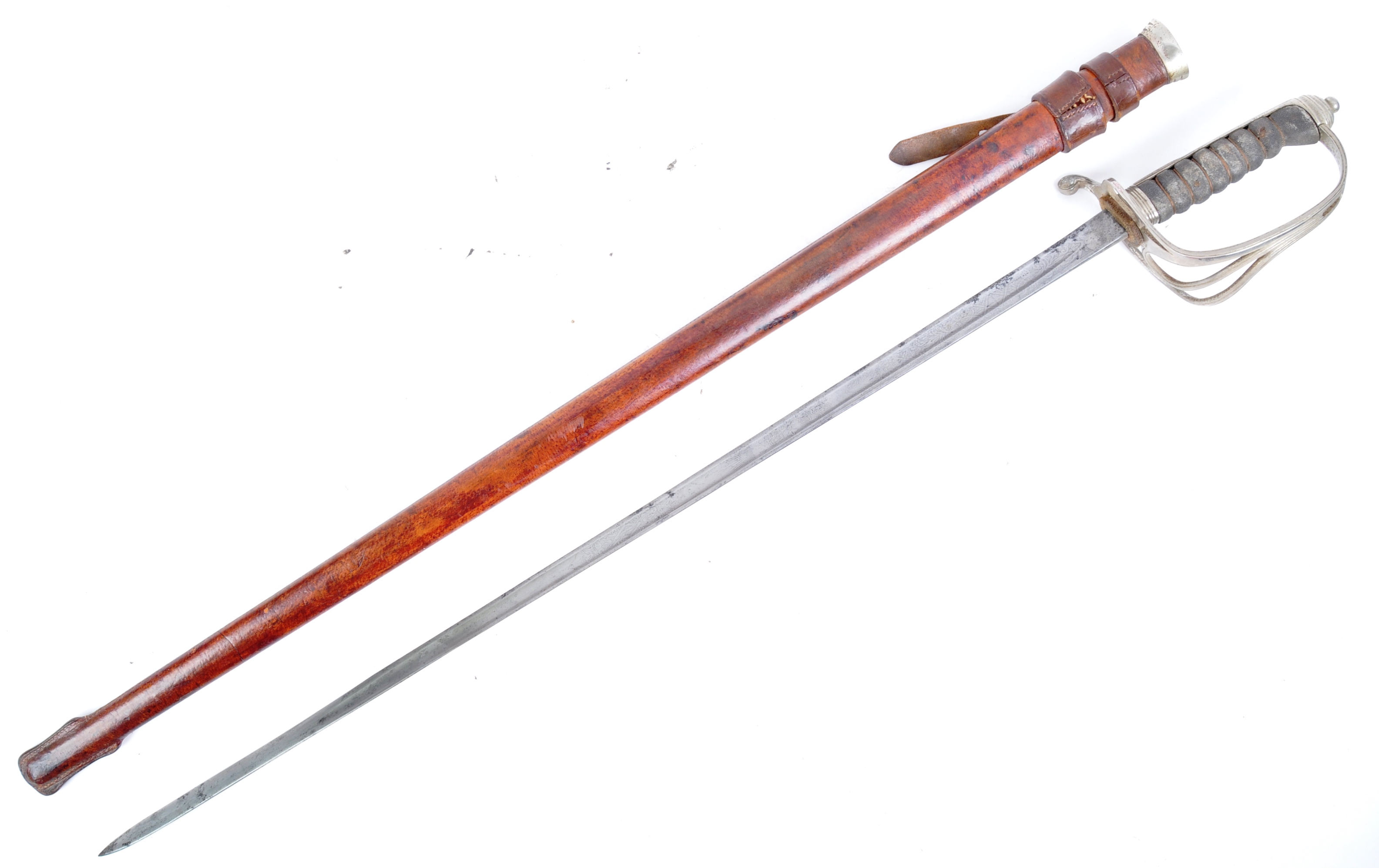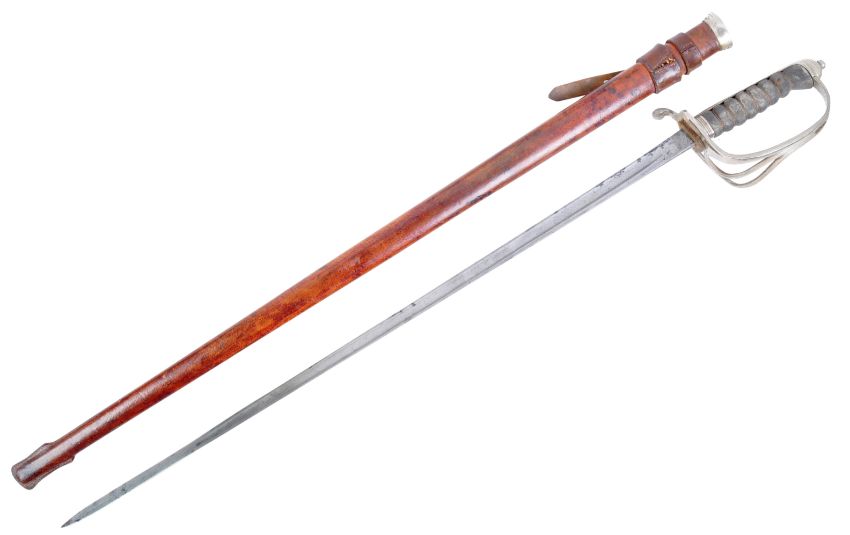31.5" straight, double-edged un-fullered spear point blade. 6" gilt sterling silver hilt hallmarked on rear of upper crossguard for the London Assay Office, 1814 with the maker mark T.P that may be the mark of Thomas Pepper II, Thomas Pitts II or Thomas Purver, all London silversmiths who used similar marks during the period. Pommel cap in the form of a rampant lion, grip with panoplies of arms, 5.25" cross guard with foliate sprays. Blade with faux Damascus patterning and etched gold gilt geometric decorations in Turkish form, with a large presentation panel of the reverse that reads in three lines: TO HIS EXCELLENCY MAJOR GENERAL AINSLIE GOVERNOR OF DOMINICA &c &c &c / THIS SWORD IS PRESENTED BY THE TWO BRANCHES OF THE LEGISLATURE / IN TESTIMONY OF HIS MERITORIOUS CONDUCT IN THE REDUCTION OF THE MAROONS IN THE YEAR MDCCCXIV. The obverse is decorated with more etching of Turkish inspired geometric patterns. The sword is accompanied by its original scarlet velvet covered wood scabbard with gilt sterling mounts that are again London hallmarked and maker marked to 1814. The mounts are engraved with panoplies of arms and martial themes with a single suspension ring on each of the two upper mounts in the form of a serpent eating its tail. The rear of the upper mount is engraved in three lines: Rundell Bridge & / Rundell / London. The sword and scabbard are produced in the "Turkish Pattern," as evidenced by the maker's own calling card of the period which read in part: "All sorts of Turkish ornaments in the newest taste after the most approved drawings and models from their agents in Constantinople. Rich diamond and enameled sabers, daggers, knives snuff boxes, watches, pistols, etc." Rundell, Bridge & Rundell worked in London ca1805-1833, starting as Rundell & Bridge ca1785 and becoming Rundell, Bridge & Co ca 1834. (Bezdek) A truly unique and high quality sword, awarded to Ainslie for his brutal handling of the Maroons on Dominica during 1813-1814. George Robert Ainslie (1776-1839) was born near Edinburgh in 1776, the son of Sir Philip Ainslie. Geroge's mother was a daughter of Lord Grey, so with a landed knight for a father and the political influence of this mother he was destined to be successful in the British military or government, no matter what his actual abilities were. George entered the military in 1793 as an ensign in the 19th Regiment of Foot and quickly advanced to lieutenant. He then received a captaincy in the 85th Regiment of Foot and soon thereafter a promotion to major. In a period when commissions in the British military were more often purchased than earned, Ainslie's wealth and political influence helped to advance his military career rapidly. The 85th saw action in Flanders in 1799 as part of the War of Second Coalition during the Napoleonic Wars, where Ainslie showed no particular martial aptitude or ability, and after the "tactical retreat" of the Anglo-Russian Forces, he was again promoted; this time to lieutenant colonel and transferred to a Fencibles Regiment (militia) where his lack of leadership ability and understanding of military matters was not a significant issue. Likely due to family influence, Ainslie was returned to active service in 1807 as lieutenant colonel of the 25th Regiment of Foot and was elevated to Brevet Colonel in 1810. In 1812, family influence delivered the post of Colonial Governor General of the island of St. Eustatius in the Caribbean, along with the required promotion to the rank of general. The following year he was given the Governorship of the Island of Dominica. Ainslie arrived in Dominica at a time of unrest, as the discontent of the island's many African slaves, held in bondage on English plantations and often brutally treated, had resulted in numerous escapes and minor revolts. The escaped slaves, known as "Maroons," formed communities in the wilderness and launched a guerrilla-style campaign against the plantation owners on the island. These raids were often brutal,
31.5" straight, double-edged un-fullered spear point blade. 6" gilt sterling silver hilt hallmarked on rear of upper crossguard for the London Assay Office, 1814 with the maker mark T.P that may be the mark of Thomas Pepper II, Thomas Pitts II or Thomas Purver, all London silversmiths who used similar marks during the period. Pommel cap in the form of a rampant lion, grip with panoplies of arms, 5.25" cross guard with foliate sprays. Blade with faux Damascus patterning and etched gold gilt geometric decorations in Turkish form, with a large presentation panel of the reverse that reads in three lines: TO HIS EXCELLENCY MAJOR GENERAL AINSLIE GOVERNOR OF DOMINICA &c &c &c / THIS SWORD IS PRESENTED BY THE TWO BRANCHES OF THE LEGISLATURE / IN TESTIMONY OF HIS MERITORIOUS CONDUCT IN THE REDUCTION OF THE MAROONS IN THE YEAR MDCCCXIV. The obverse is decorated with more etching of Turkish inspired geometric patterns. The sword is accompanied by its original scarlet velvet covered wood scabbard with gilt sterling mounts that are again London hallmarked and maker marked to 1814. The mounts are engraved with panoplies of arms and martial themes with a single suspension ring on each of the two upper mounts in the form of a serpent eating its tail. The rear of the upper mount is engraved in three lines: Rundell Bridge & / Rundell / London. The sword and scabbard are produced in the "Turkish Pattern," as evidenced by the maker's own calling card of the period which read in part: "All sorts of Turkish ornaments in the newest taste after the most approved drawings and models from their agents in Constantinople. Rich diamond and enameled sabers, daggers, knives snuff boxes, watches, pistols, etc." Rundell, Bridge & Rundell worked in London ca1805-1833, starting as Rundell & Bridge ca1785 and becoming Rundell, Bridge & Co ca 1834. (Bezdek) A truly unique and high quality sword, awarded to Ainslie for his brutal handling of the Maroons on Dominica during 1813-1814. George Robert Ainslie (1776-1839) was born near Edinburgh in 1776, the son of Sir Philip Ainslie. Geroge's mother was a daughter of Lord Grey, so with a landed knight for a father and the political influence of this mother he was destined to be successful in the British military or government, no matter what his actual abilities were. George entered the military in 1793 as an ensign in the 19th Regiment of Foot and quickly advanced to lieutenant. He then received a captaincy in the 85th Regiment of Foot and soon thereafter a promotion to major. In a period when commissions in the British military were more often purchased than earned, Ainslie's wealth and political influence helped to advance his military career rapidly. The 85th saw action in Flanders in 1799 as part of the War of Second Coalition during the Napoleonic Wars, where Ainslie showed no particular martial aptitude or ability, and after the "tactical retreat" of the Anglo-Russian Forces, he was again promoted; this time to lieutenant colonel and transferred to a Fencibles Regiment (militia) where his lack of leadership ability and understanding of military matters was not a significant issue. Likely due to family influence, Ainslie was returned to active service in 1807 as lieutenant colonel of the 25th Regiment of Foot and was elevated to Brevet Colonel in 1810. In 1812, family influence delivered the post of Colonial Governor General of the island of St. Eustatius in the Caribbean, along with the required promotion to the rank of general. The following year he was given the Governorship of the Island of Dominica. Ainslie arrived in Dominica at a time of unrest, as the discontent of the island's many African slaves, held in bondage on English plantations and often brutally treated, had resulted in numerous escapes and minor revolts. The escaped slaves, known as "Maroons," formed communities in the wilderness and launched a guerrilla-style campaign against the plantation owners on the island. These raids were often brutal,














Testen Sie LotSearch und seine Premium-Features 7 Tage - ohne Kosten!
Lassen Sie sich automatisch über neue Objekte in kommenden Auktionen benachrichtigen.
Suchauftrag anlegen